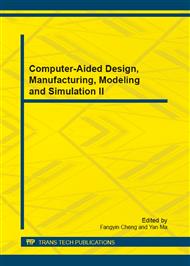[1]
Y.D. Lang. Y.X. Yao. and P.J. Xial. (2008) Virtual Assembly System for Large-Scale Complex Products, Applied Mechanics and Materials, 10, 444~450.
DOI: 10.4028/www.scientific.net/amm.10-12.444
Google Scholar
[2]
S. Jayaram. and H.I. Connacher. (1997) Virtual Assembly Using Virtual Reality Techniques, Computer Aided Design, 29, 575~584.
DOI: 10.1016/s0010-4485(96)00094-2
Google Scholar
[3]
Z. Liu. and J. Tan. (2007) Constrained behavior manipulation for interactive assembly in a virtual environment, Int. Journal Manufacture Technology, 32, 797~810.
DOI: 10.1007/s00170-005-0382-5
Google Scholar
[4]
B. Antonishek. and D. Egts. (1998) Virtual Assembly Using Two-Handed Interaction Techniques on the Virtual Workbench, ASME Design Engineering Technical Conference, 5536~5540.
DOI: 10.1115/detc98/cie-5540
Google Scholar
[5]
Zheng Yi. Ning Ruxin. and Tang Chengtong. (2006) Research and Realization of 3-Pipe-Projection Virtual Assembly Environment, Journal of computer-aided design & Computer Graphic., 18, 314-320.
Google Scholar
[6]
C. Cruz-Neira. and D.J. Sandin. (1993) Surround-Screen Projection-Based Virtual Reality: the Design and Implementation of the CAVE, Proc. SIGGRAPH 93, 135~142.
DOI: 10.1145/166117.166134
Google Scholar
[7]
G.H. Liu. and Y.X. Yao. (2006) Development of a New Virtual Environment System for Assembly, Key Engineering Materials, 316, 556~560.
DOI: 10.4028/www.scientific.net/kem.315-316.556
Google Scholar
[8]
Xia Pingjun. Lang Yuedong. and Cheng Peng. (2008) Study on Virtual Assembly Technology for Complex Products, Mechanical Science and Technology for Aerospace Engineering, 27, 1001~1004.
Google Scholar
[9]
G. Bell. (1992) An Insider Views on the Technology and Evolution of Parallel Computing, Software for Parallel Computers, 26~28.
Google Scholar
[10]
W. Kresse. D. Reinersa. and C. Knöpfle. (2003) Color Consistency for Digital Multi-Projector Stereo Display Systems: The HEyeWall and the Digital CAVE, Int. Immersive Projection Technologies Workshop. The Euro graphics Association, 271~279.
DOI: 10.1145/769953.769985
Google Scholar
[11]
Xiuhui Wang. Wei Hua. and Hujun Bao. (2005) Interactive 3D Editing on Tiled Display Wall. The International Conference on Computation Science and Application. (ICCSA2005), 215-224.
DOI: 10.1007/11424857_24
Google Scholar
[12]
LIU Zhen. SHI Jiao-ying. and PENG Hao-yu. (2006) A Survey of Cluster-based Parallel Rendering System, Journal of System Simulation, 18, 70~72.
Google Scholar


